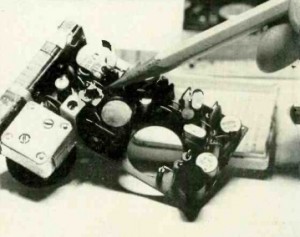 Fifty years ago this month, the September 1967 issue of Radio Electronics gave some pointers for servicemen to tackle the repair of small transistor radios. The article acknowledged that many radio men were unwilling to take on such a small job: “Don’t look at that small pocket transistor set and say, ‘We don’t fix them.’ Why let Joe’s Radio Repair down the street have the job?”
Fifty years ago this month, the September 1967 issue of Radio Electronics gave some pointers for servicemen to tackle the repair of small transistor radios. The article acknowledged that many radio men were unwilling to take on such a small job: “Don’t look at that small pocket transistor set and say, ‘We don’t fix them.’ Why let Joe’s Radio Repair down the street have the job?”
But there was money to be made, as long as the repairman could work efficiently. And more importantly, the customer probably owned other radios and televisions:
Why learn transistor radio servicing? One of our customers–Mr. Jones—has eight of them in his household. We repair them and make money doing it. Oh, yes . . . I almost forgot: Mr. Jones also has two automobiles with a radio in each, two TV sets, one small table radio, and I just sold him a big stereo set last Christmas.
 The key philosophy of repair was that “basic equipment with knowledge beats elaborate equipment and no knowledge.” After checking for obvious problems, the best starting point was at the volume control, where an AF signal was injected. Then, the serviceman would work his way back injecting AF, IF, or RF until the bad stage was found.
The key philosophy of repair was that “basic equipment with knowledge beats elaborate equipment and no knowledge.” After checking for obvious problems, the best starting point was at the volume control, where an AF signal was injected. Then, the serviceman would work his way back injecting AF, IF, or RF until the bad stage was found.
Stubborn little culprits were sometimes the source of trouble. For example, the author encountered one set that was going through batteries much faster than expected. The problem turned out to be a short across the power switch–the radio was never completely turned off. Instead, it was just turned down all the way to minimum volume.
Radios sometimes got dropped, resulting in a cracked printed circuit board. Of course, the ideal method of repair would be to order a new board and move all of the parts. But no customer would want to go to the time and expense of doing this. And it was a relatively simple matter to locate the break and jumper the broken traces (and a few others, for good measure) with hookup wire.
